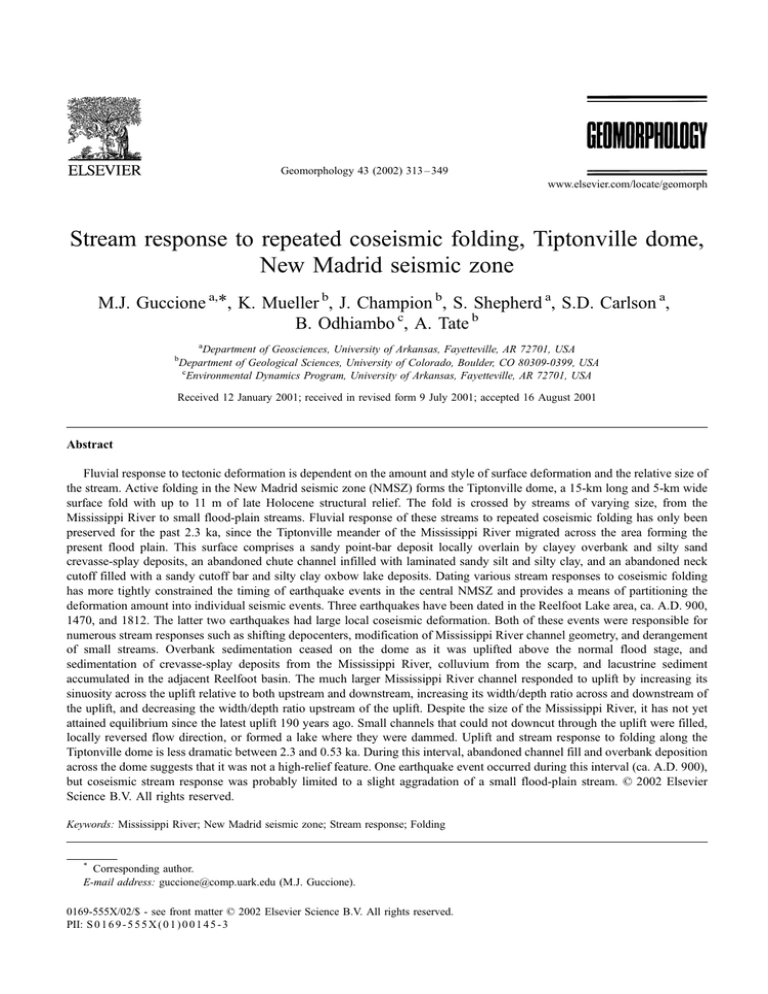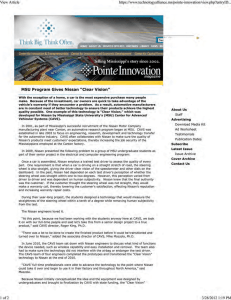
Geomorphology 43 (2002) 313 – 349
www.elsevier.com/locate/geomorph
Stream response to repeated coseismic folding, Tiptonville dome,
New Madrid seismic zone
M.J. Guccione a,*, K. Mueller b, J. Champion b, S. Shepherd a, S.D. Carlson a,
B. Odhiambo c, A. Tate b
a
Department of Geosciences, University of Arkansas, Fayetteville, AR 72701, USA
Department of Geological Sciences, University of Colorado, Boulder, CO 80309-0399, USA
c
Environmental Dynamics Program, University of Arkansas, Fayetteville, AR 72701, USA
b
Received 12 January 2001; received in revised form 9 July 2001; accepted 16 August 2001
Abstract
Fluvial response to tectonic deformation is dependent on the amount and style of surface deformation and the relative size of
the stream. Active folding in the New Madrid seismic zone (NMSZ) forms the Tiptonville dome, a 15-km long and 5-km wide
surface fold with up to 11 m of late Holocene structural relief. The fold is crossed by streams of varying size, from the
Mississippi River to small flood-plain streams. Fluvial response of these streams to repeated coseismic folding has only been
preserved for the past 2.3 ka, since the Tiptonville meander of the Mississippi River migrated across the area forming the
present flood plain. This surface comprises a sandy point-bar deposit locally overlain by clayey overbank and silty sand
crevasse-splay deposits, an abandoned chute channel infilled with laminated sandy silt and silty clay, and an abandoned neck
cutoff filled with a sandy cutoff bar and silty clay oxbow lake deposits. Dating various stream responses to coseismic folding
has more tightly constrained the timing of earthquake events in the central NMSZ and provides a means of partitioning the
deformation amount into individual seismic events. Three earthquakes have been dated in the Reelfoot Lake area, ca. A.D. 900,
1470, and 1812. The latter two earthquakes had large local coseismic deformation. Both of these events were responsible for
numerous stream responses such as shifting depocenters, modification of Mississippi River channel geometry, and derangement
of small streams. Overbank sedimentation ceased on the dome as it was uplifted above the normal flood stage, and
sedimentation of crevasse-splay deposits from the Mississippi River, colluvium from the scarp, and lacustrine sediment
accumulated in the adjacent Reelfoot basin. The much larger Mississippi River channel responded to uplift by increasing its
sinuosity across the uplift relative to both upstream and downstream, increasing its width/depth ratio across and downstream of
the uplift, and decreasing the width/depth ratio upstream of the uplift. Despite the size of the Mississippi River, it has not yet
attained equilibrium since the latest uplift 190 years ago. Small channels that could not downcut through the uplift were filled,
locally reversed flow direction, or formed a lake where they were dammed. Uplift and stream response to folding along the
Tiptonville dome is less dramatic between 2.3 and 0.53 ka. During this interval, abandoned channel fill and overbank deposition
across the dome suggests that it was not a high-relief feature. One earthquake event occurred during this interval (ca. A.D. 900),
but coseismic stream response was probably limited to a slight aggradation of a small flood-plain stream. D 2002 Elsevier
Science B.V. All rights reserved.
Keywords: Mississippi River; New Madrid seismic zone; Stream response; Folding
*
Corresponding author.
E-mail address: guccione@comp.uark.edu (M.J. Guccione).
0169-555X/02/$ - see front matter D 2002 Elsevier Science B.V. All rights reserved.
PII: S 0 1 6 9 - 5 5 5 X ( 0 1 ) 0 0 1 4 5 - 3




